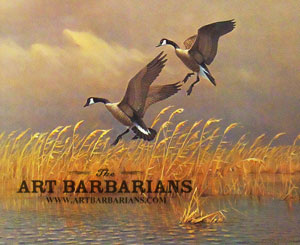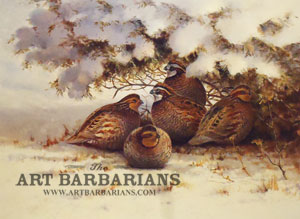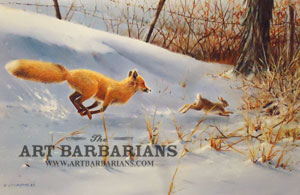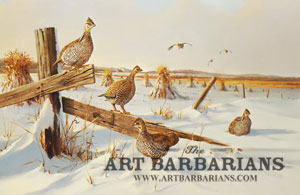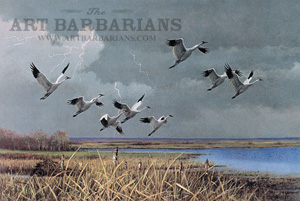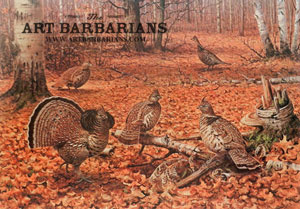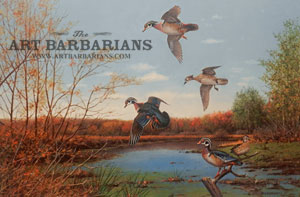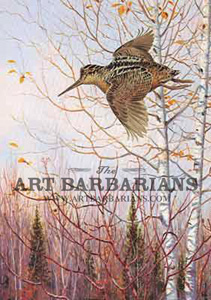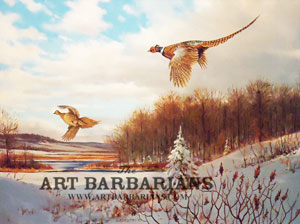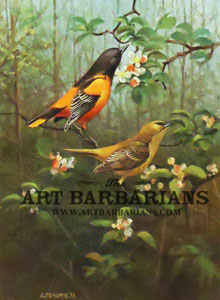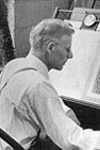 Owen Justus Gromme was born in Fond du Lac, Wisconsin on July 5th 1896 and grew up along the shores of Lake Winnebago. There during his early formative years he learned the ways of nature from his father and the local hunters, trappers and woodsmen that made this region their home. From his high school assembly room, he watched massive flocks of waterfowl staging on Lake Winnebago (one of the reasons he claims he never graduated from high school. Read moreOwen Justus Gromme was born in Fond du Lac, Wisconsin on July 5th 1896 and grew up along the shores of Lake Winnebago. There during his early formative years he learned the ways of nature from his father and the local hunters, trappers and woodsmen that made this region their home. From his high school assembly room, he watched massive flocks of waterfowl staging on Lake Winnebago (one of the reasons he claims he never graduated from high school.) He shot Prairie Chickens and geese and spent his days in the wetlands, fields and forests near his home. This was a time of great learning for Gromme and a time that influenced the remainder of his life.
Gromme worked at the Milwaukee Public Museum for 43 years, beginning in 1922, retiring from the post of Curator of Birds and Mammals in January 1965. While in this position he traveled extensively on museum expeditions, collecting documenting and recording the vast variety of life forms he encountered including one to Alaska and another to Hudson Bay country. Color notes both written and in oils and watercolors were made of the specimens he collected and the landscapes he encountered. The longest expedition and the one that truly became a turning point in Gromme's life was without a doubt, the Cudahy Massee African expedition of 1928-29. This African trip was the dream of the museum's director Dr. Sam Barrett and was to become the bedrock for future expansion and development at the Milwaukee Public Museum, which he envisioned to be one of the premiere natural history institutions in the US.
Barrett was accompanied by his two taxidermists, Irving Perkins and of course Owen Gromme. During the ensuing 8 months, they collected an impressive 312 mammals, 1390 birds and thousands of artifacts. In addition, Gromme, who Barrett had designated as artist for the trip painted nearly 100 field sketches of birds and several dozen landscapes. Before the expedition, Gromme was a keen hunter and taxidermist. With this, his first real, extended and intensive museum expedition, Gromme stepped forth into the realm of painting and evolved into what was termed, a museum man. In Gromme's own words, a good museum man had a solid background as an all around scientist, artist, carver, sculptor, lecturer, writer, photographer, bookkeeper, taxidermist and hunter. During Gromme's years at the museum he became the consummate museum man.
In addition to collecting birds and creating exhibits for the museum, Gromme began collecting data on Wisconsin's wildlife and documented population fluctuations. He is also responsible for building a major portion of the current scientific bird skin collection and creating such exhibits as the Bonaventure Island Group, The Great Blue Heron Group, The Loon Group, The Wisconsin River Peregrine Falcon Group and most of the bird mounts in the Horicon Marsh Diorama. The fact that Gromme collected, prepared and installed much of this material himself further attests to his abilities as a field collector and an artist.
Although Gromme was kept busy with his field collecting and creating scientifically accurate museum dioramas, he also built a series of mini dioramas or vignettes that were circulated throughout the Milwaukee school system. Gromme created nearly sixty of these exhibits and most of these are still being circulated today.
All throughout his museum career Gromme continued to paint but his stance on environmental issues and conservation of wildlife resources often times proved to be paramount. Gromme became a conservationist and an activist long before conservation and activism became popular. As a consequence many of his battles were long and lonely. Walter Pelzer, Gromme's close associate and former chief taxidermist here recalls that Gromme was fighting for sound wildlife laws long before most people even thought about it. Throughout the 30's Gromme's efforts alternated between taxidermy and natural history groupings to environmental causes and the training of potential museum employees.
Gromme spent over a half century defending environmental causes and donated his time and talents to conservation whenever and wherever needed. Funds from the sales of his original oil paintings and reproduction rights to his prints have netted hundreds of thousands of dollars towards conservation oriented projects. Gromme helped found and organize the International Crane Foundation in Baraboo, Wisconsin which is fighting to save the endangered cranes of the world. His painting of Canada Geese entitled "Requiem at Horicon Marsh" helped The Wisconsin Citizens Natural Resources Association fight the federal government's irresponsible management policies at Horicon Marsh. In 1978, he was also chosen as Ducks Unlimited artist of the year and the sales from prints of his painting of Wood Ducks entitled "Fall Kaleidoscope", netted DU $600,000.00 towards waterfowl habitat protection. Most recently, Owen helped form the Wisconsin Peregrine Society and backed the reintroduction of his beloved peregrine falcons to Wisconsin by donating reproduction rights to his 1936 peregrine falcon painting to the Society.
In September 1927, Gromme married the former Anne Nielsen of Briggsville, Wisconsin, who was one of his co-workers at the Museum at the time. They had two children, a son and a daughter.
Over the years, many awards have been bestowed upon Gromme. He was a high school dropout, yet went on to receive no less that five honorary doctorates for his environmental work and of course his book, "Birds of Wisconsin" illustrated by many of his paintings. It was published in the fall of 1963 by the University of Wisconsin Press in Madison, Wisconsin, and more than 10,000 copies were sold the first year and is now in its second printing of 5,000. Other publications which contain his work include "Birds of Colorado;" the frontispiece for "The Wild Turkey" by A.W. Schorger, published by the University of Oklahoma Press; and the jacket cover of "Birds Will Come to You," by C.P. Fox, Circus World Museum, Baraboo, Wisconsin, published by Reilly Company. In addition he authored over sixty published articles.
Gromme was also involved in helping the Leigh Yawkey Woodson Art Museum in Wausau develop it's annual BIRDS IN ART exhibition. Over the years, his paintings have been widely exhibited. He had paintings in a traveling exhibit of the Audubon Society; a show in Thomasville, Georgia; several exhibits in Milwaukee and other cities. Many magazines and newspapers have carried articles about him with reproductions of his paintings.
In 1967, Mr. Gromme began work on a series of paintings for the Marshall & Ilsley Bank of Milwaukee. The project took about two years and provided a complete gallery of his work for the new building which the company was constructing.
Owen J. Gromme was Curator Emeritus of the Milwaukee Public Museum; a member of the Art Commission of the City of Milwaukee; a judge for an International Decoy Contest held at the Mississippi Valley Fair in Davenport, Iowa; an Advisor on the Film Committee for Encyclopedia Britannica; and belonged to the Audubon Society; American Ornithologists' Union; National Wildlife Society; Wisconsin Society for Ornithologists; Wisconsin Academy of Arts, Science and Letters; Izaak Walton League of America; and the Seven Arts Society of Milwaukee.
Gromme died on October 29, 1991.
less
Owen Justus Gromme was born in Fond du Lac, Wisconsin on July 5th 1896 and grew up along the shores of Lake Winnebago. There during his early formative years he learned the ways of nature from his father and the local hunters, trappers and woodsmen that made this region their home. From his high school assembly room, he watched massive flocks of waterfowl staging on Lake Winnebago (one of the reasons he claims he never graduated from high school. Read moreOwen Justus Gromme was born in Fond du Lac, Wisconsin on July 5th 1896 and grew up along the shores of Lake Winnebago. There during his early formative years he learned the ways of nature from his father and the local hunters, trappers and woodsmen that made this region their home. From his high school assembly room, he watched massive flocks of waterfowl staging on Lake Winnebago (one of the reasons he claims he never graduated from high school.) He shot Prairie Chickens and geese and spent his days in the wetlands, fields and forests near his home. This was a time of great learning for Gromme and a time that influenced the remainder of his life.
Gromme worked at the Milwaukee Public Museum for 43 years, beginning in 1922, retiring from the post of Curator of Birds and Mammals in January 1965. While in this position he traveled extensively on museum expeditions, collecting documenting and recording the vast variety of life forms he encountered including one to Alaska and another to Hudson Bay country. Color notes both written and in oils and watercolors were made of the specimens he collected and the landscapes he encountered. The longest expedition and the one that truly became a turning point in Gromme's life was without a doubt, the Cudahy Massee African expedition of 1928-29. This African trip was the dream of the museum's director Dr. Sam Barrett and was to become the bedrock for future expansion and development at the Milwaukee Public Museum, which he envisioned to be one of the premiere natural history institutions in the US.
Barrett was accompanied by his two taxidermists, Irving Perkins and of course Owen Gromme. During the ensuing 8 months, they collected an impressive 312 mammals, 1390 birds and thousands of artifacts. In addition, Gromme, who Barrett had designated as artist for the trip painted nearly 100 field sketches of birds and several dozen landscapes. Before the expedition, Gromme was a keen hunter and taxidermist. With this, his first real, extended and intensive museum expedition, Gromme stepped forth into the realm of painting and evolved into what was termed, a museum man. In Gromme's own words, a good museum man had a solid background as an all around scientist, artist, carver, sculptor, lecturer, writer, photographer, bookkeeper, taxidermist and hunter. During Gromme's years at the museum he became the consummate museum man.
In addition to collecting birds and creating exhibits for the museum, Gromme began collecting data on Wisconsin's wildlife and documented population fluctuations. He is also responsible for building a major portion of the current scientific bird skin collection and creating such exhibits as the Bonaventure Island Group, The Great Blue Heron Group, The Loon Group, The Wisconsin River Peregrine Falcon Group and most of the bird mounts in the Horicon Marsh Diorama. The fact that Gromme collected, prepared and installed much of this material himself further attests to his abilities as a field collector and an artist.
Although Gromme was kept busy with his field collecting and creating scientifically accurate museum dioramas, he also built a series of mini dioramas or vignettes that were circulated throughout the Milwaukee school system. Gromme created nearly sixty of these exhibits and most of these are still being circulated today.
All throughout his museum career Gromme continued to paint but his stance on environmental issues and conservation of wildlife resources often times proved to be paramount. Gromme became a conservationist and an activist long before conservation and activism became popular. As a consequence many of his battles were long and lonely. Walter Pelzer, Gromme's close associate and former chief taxidermist here recalls that Gromme was fighting for sound wildlife laws long before most people even thought about it. Throughout the 30's Gromme's efforts alternated between taxidermy and natural history groupings to environmental causes and the training of potential museum employees.
Gromme spent over a half century defending environmental causes and donated his time and talents to conservation whenever and wherever needed. Funds from the sales of his original oil paintings and reproduction rights to his prints have netted hundreds of thousands of dollars towards conservation oriented projects. Gromme helped found and organize the International Crane Foundation in Baraboo, Wisconsin which is fighting to save the endangered cranes of the world. His painting of Canada Geese entitled "Requiem at Horicon Marsh" helped The Wisconsin Citizens Natural Resources Association fight the federal government's irresponsible management policies at Horicon Marsh. In 1978, he was also chosen as Ducks Unlimited artist of the year and the sales from prints of his painting of Wood Ducks entitled "Fall Kaleidoscope", netted DU $600,000.00 towards waterfowl habitat protection. Most recently, Owen helped form the Wisconsin Peregrine Society and backed the reintroduction of his beloved peregrine falcons to Wisconsin by donating reproduction rights to his 1936 peregrine falcon painting to the Society.
In September 1927, Gromme married the former Anne Nielsen of Briggsville, Wisconsin, who was one of his co-workers at the Museum at the time. They had two children, a son and a daughter.
Over the years, many awards have been bestowed upon Gromme. He was a high school dropout, yet went on to receive no less that five honorary doctorates for his environmental work and of course his book, "Birds of Wisconsin" illustrated by many of his paintings. It was published in the fall of 1963 by the University of Wisconsin Press in Madison, Wisconsin, and more than 10,000 copies were sold the first year and is now in its second printing of 5,000. Other publications which contain his work include "Birds of Colorado;" the frontispiece for "The Wild Turkey" by A.W. Schorger, published by the University of Oklahoma Press; and the jacket cover of "Birds Will Come to You," by C.P. Fox, Circus World Museum, Baraboo, Wisconsin, published by Reilly Company. In addition he authored over sixty published articles.
Gromme was also involved in helping the Leigh Yawkey Woodson Art Museum in Wausau develop it's annual BIRDS IN ART exhibition. Over the years, his paintings have been widely exhibited. He had paintings in a traveling exhibit of the Audubon Society; a show in Thomasville, Georgia; several exhibits in Milwaukee and other cities. Many magazines and newspapers have carried articles about him with reproductions of his paintings.
In 1967, Mr. Gromme began work on a series of paintings for the Marshall & Ilsley Bank of Milwaukee. The project took about two years and provided a complete gallery of his work for the new building which the company was constructing.
Owen J. Gromme was Curator Emeritus of the Milwaukee Public Museum; a member of the Art Commission of the City of Milwaukee; a judge for an International Decoy Contest held at the Mississippi Valley Fair in Davenport, Iowa; an Advisor on the Film Committee for Encyclopedia Britannica; and belonged to the Audubon Society; American Ornithologists' Union; National Wildlife Society; Wisconsin Society for Ornithologists; Wisconsin Academy of Arts, Science and Letters; Izaak Walton League of America; and the Seven Arts Society of Milwaukee.
Gromme died on October 29, 1991.
less
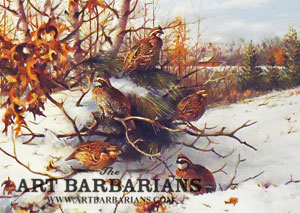
1983 International Quail Research Print and Stamp by Owen Gromme
|
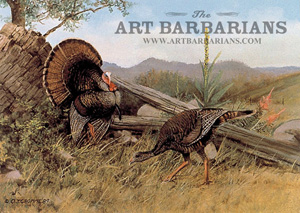
A Long Courtship - Wild Turkeys By Owen Gromme
|




